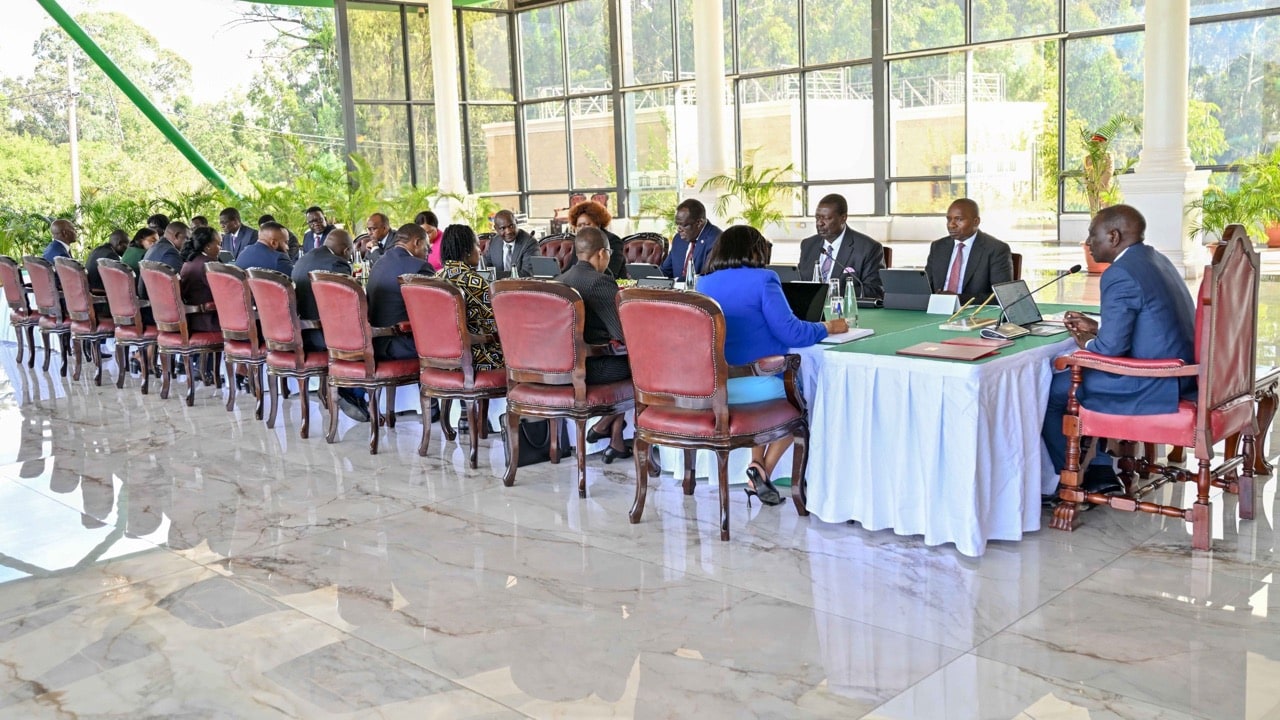Introduction
On January 21, 2025, Kenya’s Cabinet approved a detailed plan to restructure state corporations during a regular session. The plan outlines measures to streamline operations across various government entities by merging, dissolving, or privatizing selected state corporations. This move aims to address inefficiencies, eliminate redundancy, and optimize service delivery in alignment with national development goals.
Context and Background
Kenya’s state corporations have long faced challenges related to overlapping mandates, inefficiency, and financial mismanagement. With over KES 94.4 billion in pending bills as of March 2024, many corporations struggled to meet their obligations, creating a significant burden on public finances. Additionally, the rising national debt and increasing demand for quality public services necessitated urgent action to optimize resources and improve governance.
The restructuring aligns with the government’s “claimed” Bottom-Up Economic Transformation Agenda, which emphasizes fiscal responsibility, economic growth, and equitable development. This plan also reflects the government’s response to mounting public pressure, particularly from youth-led demonstrations calling for transparency and accountability.
The Role of Gen Z Demonstrations
In June 2024, Kenya witnessed significant protests led predominantly by Generation Z, who mobilized through social media platforms to oppose the proposed Finance Bill 2024. These demonstrations highlighted widespread dissatisfaction with systemic corruption, unemployment, and inefficiency in government institutions. The protests, widely known as the Gen Z movement, underscored the youth’s demand for tangible reforms, transparency, and accountability in public sector operations.
The restructuring of state corporations can, in part, be seen as a response to this pressure. By addressing inefficiencies and corruption, the government aims to restore public trust and demonstrate its commitment to systemic reforms. The youth’s activism served as a catalyst for this bold initiative, proving that public engagement can influence governance.
Key Decisions in the Restructuring Plan
The Cabinet’s resolution outlines a detailed roadmap for transforming Kenya’s state corporations. Here are the main components:
1. Merging 42 State Corporations into 20 Entities
To eliminate redundancy and improve operational efficiency, 42 corporations with overlapping or related mandates will be merged into 20 entities. These include:
- University Fund merging with Higher Education Loans Board.
- Kenya Tourism Board merging with Tourism Research Institute.
- Export Processing Zones Authority merging with Special Economic Zones Authority.
- Anti-Counterfeit Authority, Kenya Industrial Property Institute, and Kenya Copyright Board merging into one entity.
- Kenya Industrial Research and Development Institute merging with Kenya Industrial Estates.
- Agricultural Finance Corporation merging with Commodities Fund.
- Kenya Forest Service merging with Kenya Water Towers Agency.
- Agricultural Development Corporation merging with Kenya Animal Genetic Resource Centre.
- National Irrigation Authority merging with National Water Harvesting and Storage Authority.
- Kenya Law Reform Commission merging with National Council for Law Reporting.
- Tourism Promotion Fund merging with Tourism Fund.
- Commission for University Education, Technical and Vocational Education and Training Authority, and Kenya National Qualifications Authority merging into one entity.
- Kenya Rural Roads Authority merging with Kenya Urban Roads Authority.
- Kenya Investment Authority merging with Kenya Export Promotion and Branding Agency.
- Water Services Regulatory Board, Water Regulatory Authority, and Regional Center on Ground Water Resources, Education, Training and Research merging into one entity.
- Kenya National Trading Corporation merging with National Cereals and Produce Board.
- Uwezo Fund, Women Enterprise Fund, and Youth Enterprise Development Fund merging into one entity.
- Kenya Medical Research Institute merging with Kenya Institute of Primate Research.
- Kenya Plant Health Inspectorate Service merging with National Bio-Safety Authority.
- Agriculture and Food Authority consolidating its functions.
2. Dissolution of Nine State Corporations
Nine corporations will be dissolved, with their functions absorbed by relevant ministries or state entities. These are:
- Kenya Tsetse Fly and Trypanosomiasis Eradication Council.
- Kenya Fish Marketing Authority.
- Centre for Mathematics, Science and Technology Education in Africa.
- President’s Award – Kenya.
- Nuclear Power and Energy Agency.
- Kenya National Commission for UNESCO.
- Kenya Film Classification Board.
- National Council for Nomadic Education.
- LAPSSET Corridor Development Authority.
3. Privatization or Divesture of 16 Corporations
Sixteen corporations deemed outdated or better suited for private sector management will be privatized or dissolved. These include:
- Numerical Machining Complex.
- Scrap Metal Council.
- Kenya Fishing Industries Corporation.
- Jomo Kenyatta Foundation.
- Pyrethrum Processing Company of Kenya Ltd.
- Kenya National Shipping Line.
- School Equipment Production Unit.
- Kenya Yearbook Editorial Board.
- Kenya National Assurance Company.
- Coast Development Authority.
- Ewaso Ng’iro South Development Authority.
- Ewaso Ng’iro North Development Authority.
- Kerio Valley Development Authority.
- Lake Basin Development Authority.
- Tana and Athi Rivers Development Authority.
- Kenya Post Office Savings Bank.
4. Restructuring Six Corporations
Six corporations will undergo restructuring to better align their mandates with national goals. These are:
- Kenya Utalii College.
- Postal Corporation of Kenya.
- Bomas of Kenya.
- National Syndemic Diseases Control Council.
- Kenya Roads Board.
- National Housing Corporation.
5. Declassification of Public Funds
Four public funds currently categorized as state corporations will return to their respective ministries under strengthened governance frameworks. These include:
- Water Sector Trust Fund.
- National Environment Trust Fund.
- Sports, Arts, and Social Development Fund.
- Fish Levy Trust Fund.
6. Declassification of Professional Bodies
All professional bodies currently categorized as state corporations will be declassified and will no longer receive government budgetary allocations. These include:
- Hydrologists Registration Board.
- Clinical Officers Authority.
- Council of the Institute of Nutritionists and Dieticians.
- Kenya Health Professionals Oversight Authority.
- Kenya Medical Laboratory Technicians and Technologists Board.
- Kenya Medical Practitioners and Dentists Council.
- Public Health Officers and Technicians Council.
- Nursing Council of Kenya.
- Engineers Board of Kenya.
- Institute of Certified Investment and Financial Analysts.
- Institute of Human Resource Management.
- Kenya Institute of Supplies Management.
- Child Welfare Society of Kenya.
Broader Economic Context and Austerity Measures
The restructuring plan is part of a broader set of austerity measures introduced following the Gen Z demonstrations and public outcry over the Finance Bill 2024. To address the fiscal deficit, the government committed to reducing public expenditure and re-evaluating inefficient programs. This restructuring is a critical component of those measures, aimed at optimizing resource allocation and cutting costs.
The austerity measures include not only streamlining state corporations but also reducing unnecessary government spending in various sectors. These efforts are designed to free up resources for critical areas like healthcare, education, and infrastructure development, directly addressing the public’s demand for better service delivery.
Addressing Budgeted Corruption
Kenya’s state corporations have long been plagued by budgeted corruption—a practice where funds are allocated to ghost projects or misappropriated through inflated budgets. The restructuring initiative seeks to tackle this issue by enhancing oversight and consolidating functions under fewer, more accountable entities. By eliminating opportunities for financial mismanagement, the government aims to foster a culture of integrity and accountability within the public sector.
Redundancy of Authorities in Kenya
One of the primary drivers of this restructuring effort is the redundancy of functions across multiple state corporations. Over the years, overlapping mandates have led to inefficiencies, conflicts, and wastage of public resources. For instance, the existence of both the Kenya Tourism Board and the Tourism Research Institute created duplication in promoting the tourism sector. The merging of such entities will ensure streamlined operations and better resource utilization.
Additionally, reducing redundancies is expected to improve coordination and service delivery. By clearly defining the roles and responsibilities of each entity, the government can eliminate confusion and enhance the efficiency of public service provision.
Implications for the Public and Economy
Positive Outcomes
- Better Services: Consolidated entities will offer more streamlined and effective services.
- Cost Savings: The government will reduce unnecessary expenditures, freeing resources for critical sectors like healthcare and education.
- Economic Growth: Privatization and improved management will attract investment and drive sectoral growth.
- Public Trust: Addressing corruption and inefficiencies will restore public confidence in government institutions.
Challenges
- Job Losses: Employees of dissolved or merged corporations may face redundancies, requiring government intervention to support affected workers.
- Resistance to Change: Stakeholders within the impacted corporations may resist restructuring efforts, posing potential implementation challenges.
Public Sentiment and Government Responsiveness
The government’s restructuring efforts can also be viewed as a response to public sentiment expressed during the Gen Z protests. These demonstrations highlighted the youth’s dissatisfaction with systemic corruption and inefficiency, serving as a wake-up call for policymakers. By undertaking these reforms, the government demonstrates its attentiveness to citizens’ concerns and its commitment to implementing meaningful changes.
Conclusion
Kenya’s decision to merge and restructure state corporations is a bold and necessary step toward achieving fiscal sustainability and improved service delivery. While challenges remain, the long-term benefits of streamlined operations, reduced costs, and enhanced public services are expected to outweigh the short-term disruptions. This initiative underscores the government’s commitment to fostering economic growth, accountability, and efficiency, setting the stage for a more prosperous future. Additionally, it reflects the power of public engagement and activism in shaping governance, demonstrating that bold reforms are possible when citizens and leaders work toward a common goal.








